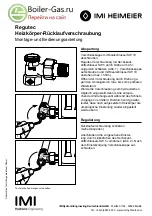
11
and/or cause a downdraft in the venting system through a
barometric damper if installed. Spillage of flue products
from the venting system into an occupied living space can
cause a very hazardous condition that must be immediately
corrected.
2.3 OUTDOOR
VENTING
The DynaFlame windproof cabinet protects the unit from
weather, when fitted with the factory supplied air intake and
UL approved vent cap (93-0298), it will be self-venting and
suitable for outdoor installation.
1. Outdoor models must be installed outdoors and must
use the Air Intake and Vent Cap supplied by Camus
Hydronics.
2. Periodically check to ensure that air intake and vent
cap are not obstructed.
3. Locate appliance at least 3 feet away from any
overhang.
4. Locate appliance at least ten feet from building air
intake.
5. Avoid installation in areas where runoff from adjacent
building can spill onto appliance.
For outdoor installations, always consider the use of a
shelter such as a garden shed in lieu of direct exposure of
the appliance to the elements. The additional protection
afforded by the shelter will help to minimize nuisance
problems with electrical connections and will allow easier
servicing of the appliance under severe weather conditions.
2.4 THRUWALL
VENTING
When fitted with the factory supplied vent terminal, the
DynaFlame can vent up to 100 equivalent feet. Elbows can
range from 7 to 19 feet in equivalent length depending on
centreline radius. Vent sizes are 6" for Model 500, 8" for
Models 750, 1100 & 1200, 10” for Models1500 & 1750, 12”
for Models 2000, 2500 & 3000, and 14” for Models 3500,
4000, 4500 & 5000
Appliances may be installed with either a horizontal
sidewall vent or vertical roof top vent. Terminals differ with
each application. Horizontal lengths over 5 feet must be
installed using corrosion resistant stainless steel. Use
single wall vent and seal all joints or use pressure rated
double wall vent.
When using single wall vent, all vent connector seams and
joints must be sealed with pressure sensitive aluminium
tape or silicone sealant as specified by the vent
manufacturer. Aluminium tape must meet the provisions of
SMACNA AFTS-100-73 Standard.
When venting through unheated spaces, use venting
material which will minimize flue gas condensation inside
the vent. Provisions must be made for collecting and
disposing of any condensation which may occur. The
authorities having jurisdiction must approve venting.
Periodically check to ensure that the vent terminal is
unobstructed.
This venting system uses the appliance’s internal
combustion air fan to force the flue products out
horizontally. Vent cap and venting must be listed type
Category IV vent materials.
The DynaFlame fan generates a positive pressure in the
flue. Combustion air is drawn from the equipment room The
THRUWALL termination caps are available from the factory
as a kit.
Refer to local codes for proper installation and location of
vent terminals.
2.4.1
THRUWALL Vent Cap (14-0090) THRUWALL
Intake Air Cap (14-0101)
•
The THRUWALL vent cap kit includes the wall
penetration assembly and the discharge screen
assembly.
•
The opening through the wall for installation of the
THRUWALL vent cap must provide an air space
clearance of 1 inch (2.5cm) around the flue pipe. The
diameter of the opening for installation of the
THRUWALL vent cap will be 2 inches (5cm) larger
than the nominal diameter of the installed vent pipe to
the THRUWALL vent cap. The diameter of the opening
for the air inlet cap will be the same as the nominal
size of the pipe.
•
Install the proper vent pipe to the vent cap (provided by
Camus Hydronics).
•
Follow all requirements in the General Venting sections
for venting flue products to the outdoors.
Table 5 – Vent and Air Inlet Cap Size
Model No.
Vent and Air Inlet cap size
500
6”
750
8”
1100
8”
1200
8”
1500
10”
1750
10”
2000
12”
2500
12”
3000
12”
3500
14”
4000
14”
4500
14”
5000
14”
2.4.2
Location of A THRUWALL Vent Termination
•
The vent cap shall terminate at least 3 feet (1M) above
any forced air inlet within 10 feet (3M) horizontally.
•
The vent cap MUST NOT terminate below a forced air
intake at any distance.
•
Do not terminate the vent in a window well, stairwell,
alcove, courtyard or other recessed area. The vent
cannot terminate below grade.
•
The vent shall not terminate less than 7 feet above a
public walkway due to the normal formation of water
vapour in the combustion process.
•
The vent system shall terminate at least 3 foot (1M)
above grade, above normal snow levels and at least 7
feet (2.15M) above grade when located adjacent to
public walkways.
•
The vent terminal shall not be installed closer than 3
feet (1M) from an inside corner of an L-shaped
Содержание DFH500
Страница 31: ...28 PART 9 TROUBLE SHOOTING ...
Страница 32: ...29 ...
Страница 39: ...36 PART 12 EXPLODED VIEW ...
Страница 40: ...37 ...
Страница 41: ...38 ...
Страница 46: ...43 PART 13 ELECTRICAL DIAGRAMS ...
Страница 47: ...44 ...
Страница 48: ...45 ...
Страница 49: ...46 ...
Страница 50: ...47 ...
Страница 51: ...48 ...















































